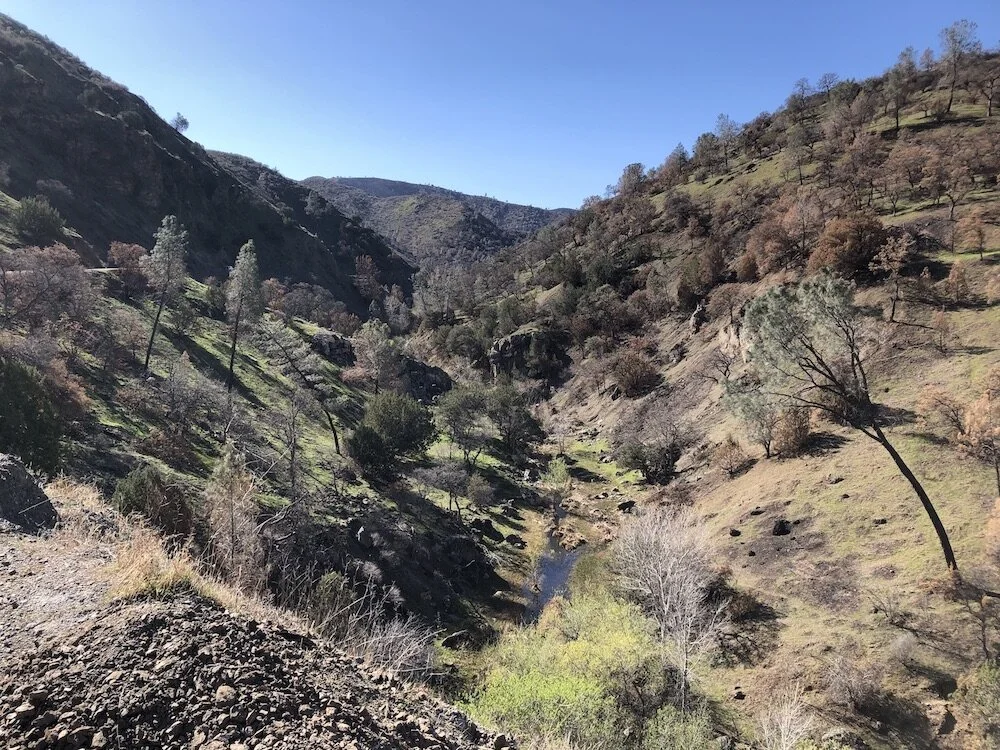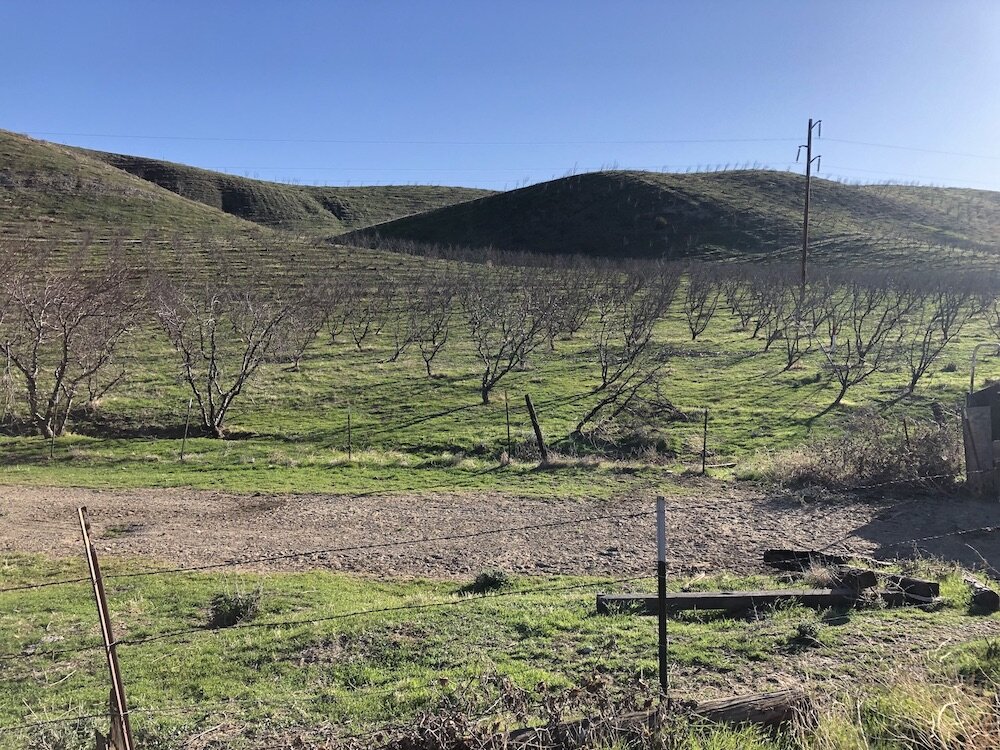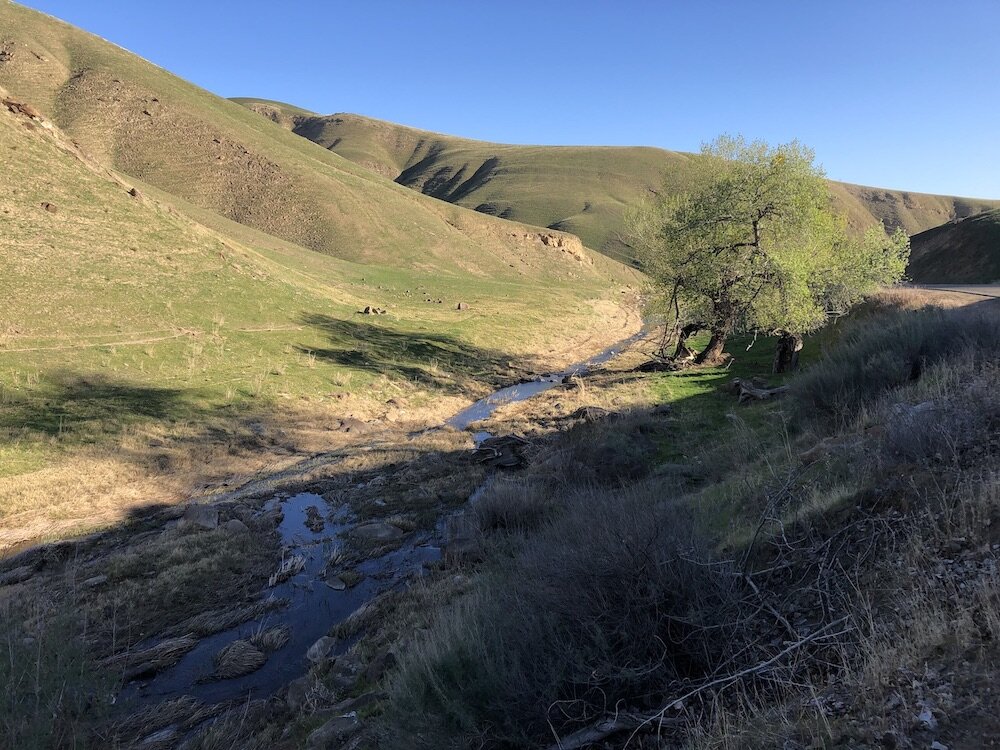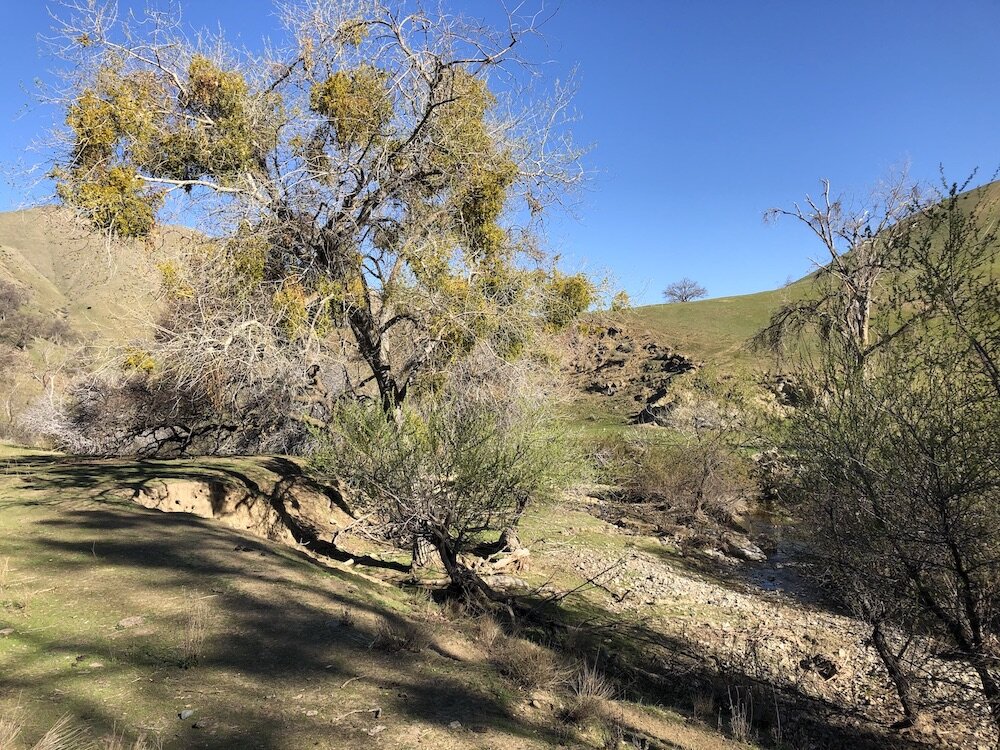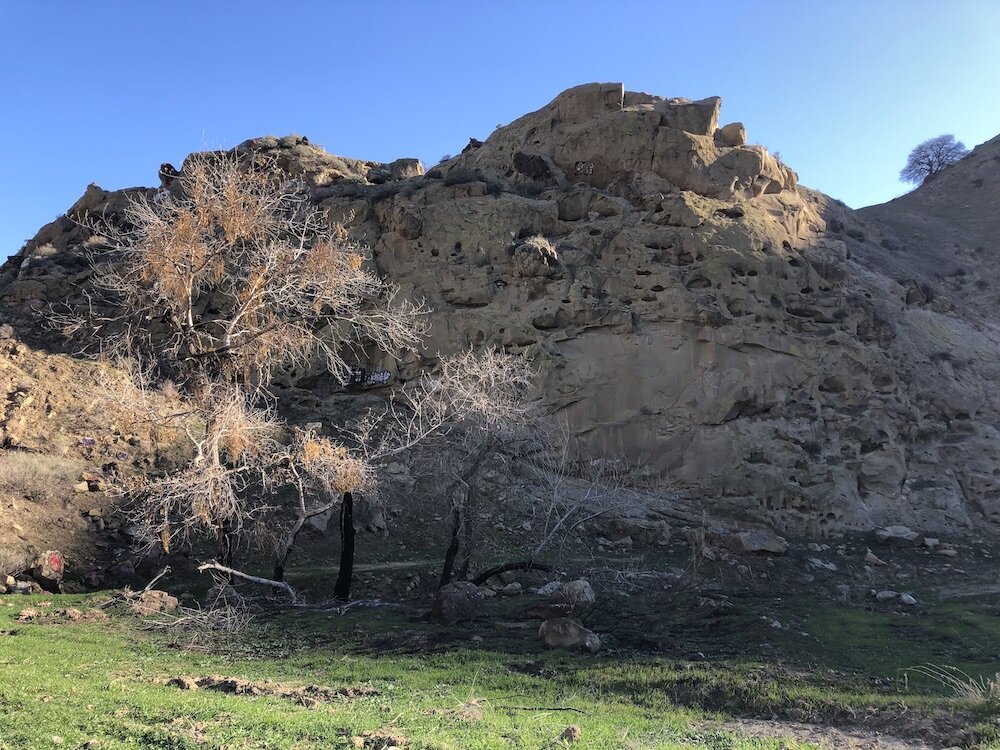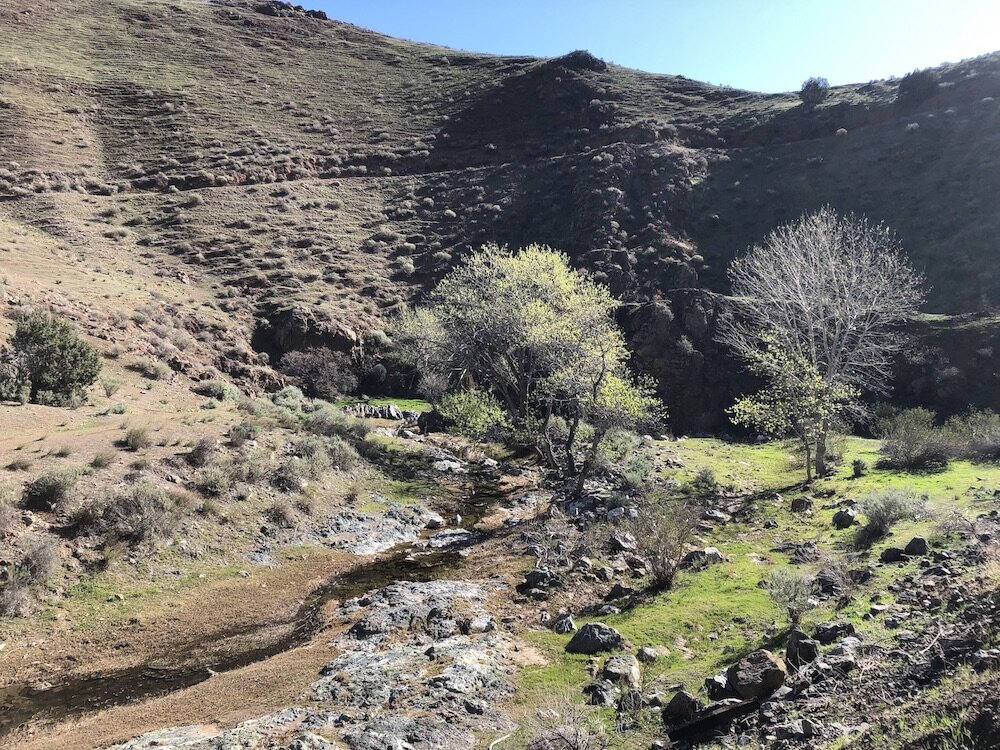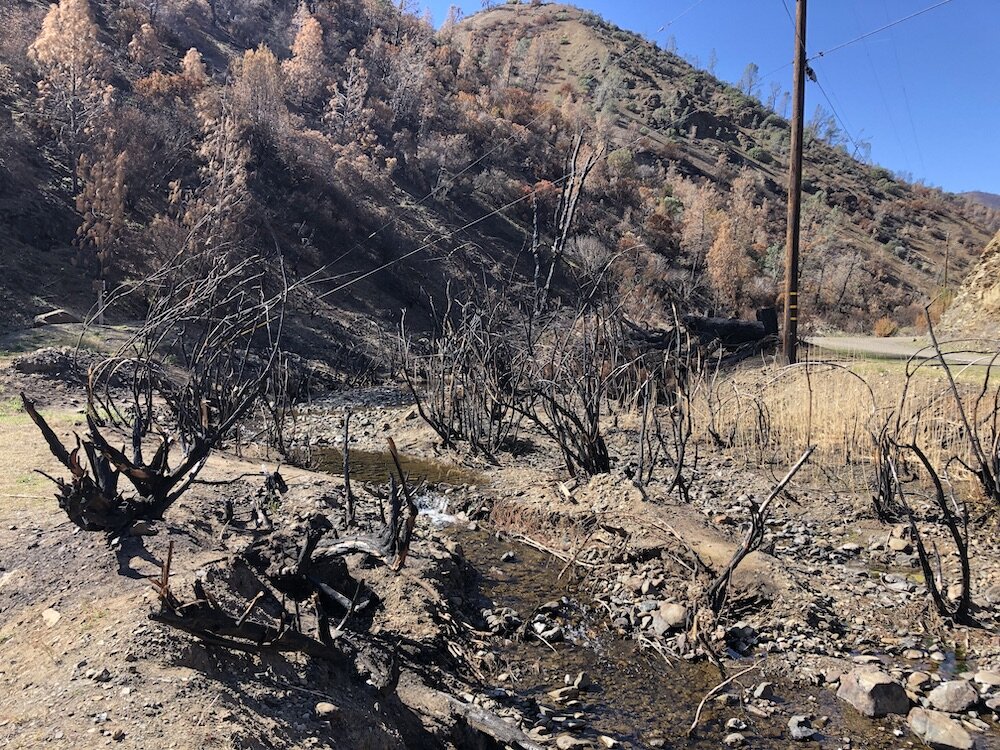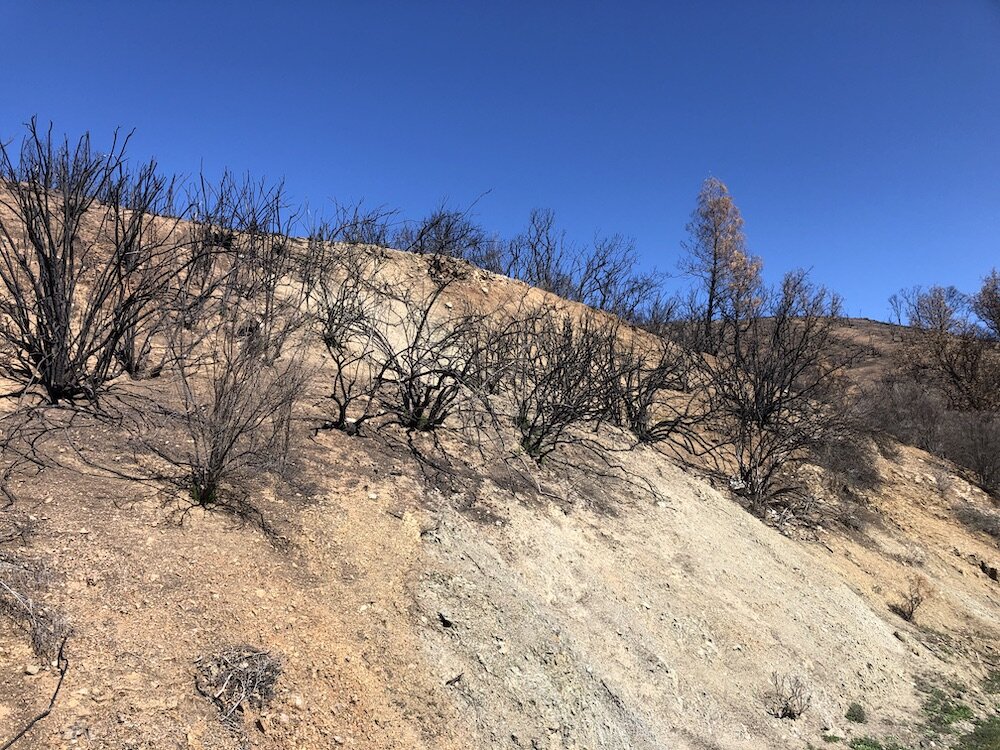San Antonio Valley and Del Puerto Canyon Road
(Spring):
From Narrow Canyon to Wide Valley—The Long Road to Recovery
by Matthew Dodder
For many years, local birders chose to visit Mines Road during spring to search for some highly-prized species such as Lewis’s Woodpecker and Lawrence’s Goldfinch. The recommended route took folks through Livermore. After climbing miles of scenic road and crossing from Alameda County into Santa Clara, birders eventually descended into San Antonio Valley where county listing resumed. They’d stop at the cattle guard near the fire station in hopes of finding birds in the vast chaparral slope. But Del Puerto Canyon was often passed by, in favor of San Antonio Valley just to the south. After a long day, birders could either backtrack to get home or keep going and brave the narrow winding road up and over Mount Hamilton.
The adventure represented a full day of birding, but usually a lot of target species were acquired, including Bell’s Sparrow, so it was definitely worth it. I’ve made this journey at least 40 times over the years and often taken class groups with me.
Maybe it was just my restlessness, but at some point I decided the experience could be improved if we changed the direction of the tour. Although it shifted the emphasis to Stanislaus County, it seemed the birding was more relaxed and roadsides a little more conducive to stops. It also seemed more exotic somehow. So, I changed the route to begin from Hwy 5 just outside of Patterson on Del Puerto Canyon Road.
The grassland and rich cottonwood riparian habitats located in Stanislaus provided more opportunities to find Grasshopper Sparrow, Blue Grosbeak, Cassin’s Kingbird and Phainopepla early in the day before heat made scope views shimmery. There was also the chance to find Costa’s Hummingbird in areas where tree tobacco was blooming.
I try to avoid telling stories of birds that “used to be found here”, or worse, “was once found here—right there in that tree”. We’ve all heard those stories, usually told by experienced birders to less experienced ones, the ones who would much rather know what’s here now, and what can be seen today. Not what used to be here…
To do that, though, I do need to give some context. It’s important to know where the birds were and to understand what they required, since only then be able to predict where they might show up in this altered environment.
Trip Covers: April - June
KEY BIRDS: Wood Duck, Greater Roadrunner, Costa’s Hummingbird, Swainson’s Hawk, Northern Pygmy-Owl, Burrowing Owl, Lewis’s Woodpecker, Olive-sided Flycatcher, Ash-throated Flycatcher, Cassin’s Kingbird, Western Kingbird, Loggerhead Shrike, Horned Lark, Rock Wren, Canyon Wren, Phainopepla, Lawrence’s Goldfinch, Grasshopper Sparrow, Chipping Sparrow, Lark Sparrow, Bell’s Sparrow, Rufous-crowned Sparrow, Yellow-breasted Chat, Tricolored Blackbird, Blue Grosbeak
HOW TO BIRD
Del Puerto Canyon Road is a 25 mile paved road from Hwy 5 to San Antonio Valley. It is remote but has a surprising number of trucks carrying livestock, water and fuel to-and-from the various ranches. The trail is also popular with motorcycles. Birding must therefore be done from the many pull outs along the road, with a constant watch for oncoming traffic. The path crosses from Stanislaus County into Santa Clara County if one begins from the east end (as this account recommends). From the “Junction” at mile 25, one can then drive north along Mines Road toward Livermore while still in Santa Clara, or drive south on San Antonio Valley Road. Both directions will take you back to the Bay in roughly the same amount of time. If you choose to head home via San Antonio Valley Road, you will drive up an over Mount Hamilton where fire damaged landscape prevails but birds can still be found. I feel car sick just thinking about it…
PERSONAL CONNECTION: Years ago, my class toured this area each spring in a caravan. I recall, only a few of us had cell phones but they didn’t work in this area anyway. They still don’t now. We hadn’t yet adopted the use of walkie-talkies like we do today. So it was a very different experience than it is now, especially with the recent fires.
I’ll begin this self-guided field trip by suggesting some historically productive stops, but afterward I want to suggest a new way to explore this area, or maybe I should say, a new attitude.
WHERE TO LOOK FOR BIRDS
Mile zero. Photo by Matthew Dodder
The rock (Mile 0)
Before beginning your drive, zero-out your odometer at the “Rock”, which is found at the east end of Del Puerto Canyon Road and reads “Frank Raines Park 16 Miles Ahead”. All mileages in this account begin at this rock (37.463440, -121.185396 - see interactive map).
The drainage. Photo by Matthew Dodder
Another view of the drainage. Photo by Matthew Dodder
The grassland (Mile .1 - .4)
The first habitat you will see is the grassland section, featuring rolling hills of short grass. Cattle is frequently found here so the grass is often quite short. A drainage at 0.1 mile (37.464400, -121.190305, #1 on map) is usually the first stop I make. Being quite close to Hwy 5 and the Patterson agricultural lands, it is not uncommon to find Swainson’s Hawk in these low hills. On the hillside you may hear Grasshopper Sparrow or in the morning see them perched on the barbed wire beside the road. Western Kingbird and Loggerhead Shrike are usually easy to find here. Blue Grosbeak may be found anywhere from the drainage here to the Owl Rock several miles away. Blue Grosbeak is drawn to moistened drainages and orchards where shrubs and small trees provide nesting habitat. Lark Sparrow is occasionally found here as well but they tend to prefer the areas closer to the cottonwoods.
The orchard. Photo by Matthew Dodder
The old orchards (Mile 0.6)
More than a decade ago, much of the grassland section was supplanted by an orchard which, due to lack of water, eventually died (37.469169, -121.194670, #2 on map). The trees remain standing in many places, but most have fallen. What was previously good habitat for Grasshopper Sparrow began to attract Blue Grosbeak, Bullock’s Oriole, Ash-throated Flycatcher and other birds that require trees. Now it attracts neither for the most part, but I keep looking.
Blue Grosbeak by Gena Zolotar
The towers. Photo by Matthew Dodder
The towers (Mile 1.7)
High tension power lines cross the road just after the parched orchards (37.478901, -121.209430, #3 on map). Here it is best to pause and scan the structures for Raptors such as Red-tailed Hawk, Golden Eagle, as well as Prairie Falcon. It is not uncommon for both Western or Cassin’s Kingbirds to make use of these towers for their nests.
The water trough. Photo by Matthew Dodder
The water trough (Mile 2.3)
Just after passing the towers, a water trough stands in a flattened area to the left side of the road (37.477768, -121.218668, #4 on map). The bare earth in this area attracts any American Pipit that might remain in the area, as well as resident Horned Lark. The barbed wire frequently has small numbers of Lark Sparrows. Rock Wren may be heard beyond the meadow on the escarpment across the road. On several occasions, we have also found Burrowing Owl near the base of the towers or in the short-grass areas, but one must be patient to find them.
Entrance to the cottonwoods. Photo by Matthew Dodder
Creek and cottonwood tree. Photo by Matthew Dodder
View of creek. Photo by Matthew Dodder
The cottonwoods (Mile 3.3)
There is a beautiful section of the road that follows the creek closely (37.473798, -121.235473, #5 on map).
It is filled with large Cottonwood trees that thrive near the water below the road and a steep slope above the road hosts large and beautiful Blue Oaks. As you might expect, the abundance of trees attracts a variety of birds from the noisy Western Kingbird and Ash-throated Flycatcher to Lark Sparrow and Bullock’s Oriole. As with any oak habitat, watch for oak mistletoe (Phoradendron villosum). If there’s mistletoe, there’s also likely to be Phainopepla.
Mistletoe. Photo by Matthew Dodder
Unfortunately, the only way to bird this area is to pull off the road either just before or just after the cottonwood section. It is risky to walk along the road and the utmost care is required. Keep a watchful eye for fast moving vehicles and be sure to stay off the pavement as much as possible while observing the creek.
I always scan along the creek for Dragonflies. Common Green Darner, Eight-spotted Skimmer, and Common Whitetail are all possible here.
Graffiti Rock. Photo by Matthew Dodder
The rocks and chaparral (Mile 3.5)
On the far end of the cottonwood section, the creek takes a sharp bend around a large rock decorated with spray paint (37.474387, -121.238302, #6 on map).
This is “Graffiti Rock”. It is not safe to park your car here, but you may drive up to the next stop and walk back along the road carefully. Be very aware of passing vehicles along this section. You will likely notice a few straggly shrubs with bright yellow tubular flowers. This is Tree Tobacco (Nicotiana glauca) and it is a favorite food source of Costa’s Hummingbird.
Costa’s Hummingbird by Brooke Miller
Tree Tobacco. Photo by Matthew Dodder
The plant and the bird are intimately connected, and these flowers are greatly responsible for the expansion northward of the desert-loving Hummingbird into our area. Look for the plant and watch for any birds drawn to it. Chances are you may find the tiny purple-throated Costa’s Hummingbird. If your ears are sharp you may also hear the birds rising-and-falling courtship “song” which clocks in at 12,000 Herz, almost twice as high as Brown Creeper and beyond most people’s hearing. This area, with its outcroppings of large boulders and California Sagebrush (Artemisia californica) is also home to Rufous-crowned Sparrow, Canyon Wren, and of course, Rock Wren.
California Sagebrush. Photo by Matthew Dodder
Scope the canyon wall from here. Photo by Matthew Dodder
Owl Canyon caves. Photo by Matthew Dodder
The canyon (Mile 3.7)
Just around the corner, another must-see area can be found. In this case there is an ample turn out and good visibility for passing vehicles (37.473070, -121.240769, #7 on map). This is “Owl Canyon” and careful investigation of the small caves on the rocky wall across the road may just prove why. American Barn Owl and Great Horned are often seen huddling deep in the shadows. A scope is recommended and patience to let your eyes adjust to the darkness within the caves. In good years, I have seen Great Horned Owlets clambering around in a nest in full view, but that is not common.
As with the cottonwood section just before, any water in the creek means Dragonflies might be present. Look for them, but also the birds that might like to eat them—birds like Western Kingbird, Ash-throated Flycatcher, and Olive-sided Flycatcher…
Oak savanna habitat. Photo by Matthew Dodder
Oak savanna habitat. Photo by Matthew Dodder
The savanna (Mile 4.2)
For the next few miles, pullouts will be rare. Birding however can be good from one’s vehicle or on long straight aways where visibility of traffic is unobstructed. Birds seen anywhere along this section include Golden Eagle, Yellow-billed Magpie, Loggerhead Shrike, Rock Wren, Canyon Wren, and Lark Sparrow. One particularly good place to pull off is near Oasis Ranch at Mile 9.6 (37.441329, -121.300405, #8 on map).
From the road, a good view of the hills and the creek may produce Green Heron, Greater Roadrunner, Prairie Falcon and Phainopepla, as well as Bullock’s Orioles and other common birds.
Canyon Wren habitat. Photo by Matthew Dodder
Canyon Wren habitat. Photo by Matthew Dodder
The crossing (Mile 10.7)
The road will climb gradually after the savanna reaching another great stop where the creek crosses from your left to your right. On the left of the road is a wide turnout where you will want to stop and explore (37.441720, -121.312843, #9 on map).
Examine the cliff wall directly above your car and scan for Rock Wren and Common Raven activity. Both nest here. And if you haven’t found Rufous-crowned Sparrow yet today, this is an excellent spot. Search among the rocks where Artemisia grows and listen for their distinctive “peer peer peer peer peer” call. Greater Roadrunner frequents this area too and will most likely be found by scanning the gravel road across the creek and the rocky ridge. Canyon Wren is often heard singing below the road along the creek. It is not uncommon to find a variety of Swallows here, including Northern Rough-winged, Violet-green, and Tree Swallows.
The creek below the road is often a good place to see a few Dragonflies, such as Flame Skimmer and Cardinal Meadowhawk.
Del Puerto Canyon. Photo by Matthew Dodder
The edge (Mile 12.3)
There are few places to stop along this stretch, but one or two turnouts with just enough room for a couple of cars provide spectacular views of the creek far below (37.438218, -121.336253, #10 on map).
Here it is best to pause for a minute, wait for your engine to stop making those funny pinging sounds, and listen for Canyon Wren. You may hear other birds as well, probably nothing new for your list, but there’s a special magic to the Canyon Wren’s song when it’s heard from an overlook. The utter quiet of this area, as long as motorcycles are not near, is wonderful and worth a few minutes to experience. You will likely have noticed the extensive fire damage in this area as well. If not, be patient, it will be impossible to miss fairly soon.
Lair of the Pygmy-Owl, supposedly. Photo by Matthew Dodder
Lovely riparian habitat. Photo by Matthew Dodder
The park (Mile 15.8, restrooms)
After you pass into the Minnear Day Use Area you will see a large pullout on your right beside the creek (37.424465, -121.342621, #11 on map). This is often a good location to find Warblers such as Common Yellowthroat, Nashville Warbler, MacGillivray’s Warbler, and even Yellow-breasted Chat. There’s no telling what will be there, but it’s worth exploring. One can even access the water by following a short trail from the gravel lot. Purple Finch and Ash-throated Flycatcher will probably be heard from this area too. This is also frequently described as the most dependable area for Northern Pygmy-Owl; however, I have usually encountered them a bit further up the road at Frank Raines Park (37.420642, -121.372912, #12 on map).
More picturesque riparian habitat. Photo by Matthew Dodder
However, before you reach the park entrance, stop at a wide turn out on your left to admire the view of the creek (37.420331, -121.345808, #13 on map). Lawrence’s Goldfinches are regularly encountered here.
Frank Raines Park entrance. Photo by Matthew Dodder
Frank Raines Park playground. Photo by Matthew Dodder
The cross on the hill. Photo by Matthew Dodder
Northern Pygmy-Owl by Matthew Dodder
Pygmy-Owls look a lot like pinecones. There are a lot of pinecones here, so if you think you’re seeing dozens of Pygmy-Owls… you might reconsider your choice of optics. The park is worth a stop, and we usually reach it right about lunch time. The bathrooms are horrifying, but among the very few opportunities you will have. Phainopepla is frequently found at the base of the hill right above the restrooms, Northern Pygmy-Owl can be found here as well. Lawrence’s Goldfinches may forage on the fiddlehead in the playing field, or up the road a bit at the campground. One time, as I was admiring an Olive-sided Flycatcher near the white cross at the far end of the parking lot, I happened upon a Greater Roadrunner hunting lizards along the fence. If your ears are very sharp, and the off-roaders are not making too much noise across the street, Bell’s Sparrow may be heard from the road in the chaparral across the creek.
It is always a good idea to drive into the OHV Park up the road a bit (37.423028, -121.381011, #14 on map). The guard keeper usually lets birders use the restrooms here, and you might see Lawrence’s Goldfinch in the campground.
Greater Roadrunner by Dave Zittin
The quarry. Photo by Matthew Dodder
Stop 12: The quarry
A wide turnout on the right provides a good location to search for Canyon Wren, Rock Wren and Rufous-crowned Sparrow. The lush riparian vegetation sometimes provides cover for various surprises—most notably, Yellow-breasted Chat (37.411682, -121.406425, #15 on map).
Adobe Springs. Photo by Matthew Dodder
Dragons be here. Photo by Matthew Dodder
The spring
A one-minute drive will find you at Adobe Springs, a curious place where parking for one or two cars can be found just across the creek. In addition to the birds just mentioned this is particularly interesting to anyone who loves Dragonflies. Grappletail, Pacific Spiketail, and the lovely American Rubyspot can be found here quite often (37.408802, -121.409056, #16 on map).
The line
Welcome to Santa Clara County! Start a new eBird checklist now…. (37.391607, -121.450419, #17 on map).
Chaparral slope. Photo by Matthew Dodder
The chaparral
There is a large, uninterrupted slope of chaparral on your left, about half a mile further (37.385960, -121.454361, #18 on map). Here is one of the best spots to look for Bell’s Sparrow along this tour. The birds may show up on either side of the road, as their favorite plant Chamise (Adenostoma fasciculatum) is found here, and they respond quite well to pishing. Be aware that when the Bell’s Sparrows are near, they make a soft call quite similar to Dark-eyed Junco. Other birds in this habitat include California Thrasher and Blue-gray Gnatcatcher.
The Tricolored Blackbird pond. Photo by Matthew Dodder
The pond
A half mile further you will reach a small pond on the right side of the road. Despite its size, this spot supports one of the largest colonies of Tricolored Blackbird in Santa Clara County (37.384473, -121.462947, #19 on map). Red-winged Blackbirds also make use of the reeds here for their nests, but the Tricoloreds dominate. It is a good opportunity to compare their coloration and call. The Tricolored Blackbird is a vibrant glossy blue-black and has a deeper red epaulette with a white margin. Our local Red-winged Blackbirds are of the “bicolored” variety which lack the yellow margin seen elsewhere in their range. Their calls are different as well, with the Tricolored sounding much like an angry cat, somewhat similar to Yellow-headed Blackbird. The other difference between the two species here is the way they fly and flock. Watch for the tight groups of Tricolored as well as their smoother flight. Dragonflies abound here. Western Pondhawk, Flame Skimmer, Cardinal Meadowhawk, Blue Dasher, Common Green Darner, Common Whitetail, Eight-spotted Skimmer… all there, buzzing around the Pied-billed Grebes and their young.
Ghosts. Photo by Matthew Dodder
The creek through a dry land. Photo by Matthew Dodder
The chaparral (part 2)
Continue for another mile to what was for many years a reliable place for Bell’s Sparrow. Now, however, it is a silent patch of blackened ghosts. Perhaps we will see Bell’s Sparrow here again, but it will be a while before the ground cover is sufficient to support this timid species (37.390953, -121.475985, #20 on map).
Bell’s Sparrow by Gena Zolotar
The Junction. Photo by Matthew Dodder
Oak savanna at the bar & grill. Photo by Matthew Dodder
The junction (restrooms)
This will be a welcome stop for weary birders. There is a restroom and a diner that attracts car clubs, motorcyclists and endurance cyclists. There are cold drinks and food available inside and a nice place to sit and reflect on your day. You can also use this as an opportunity to decide which direction to go after you rest. Most importantly, this is also a great opportunity to look for Lawrence’s Goldfinch, Chipping Sparrow and nesting Violet-green Swallows, all of which have been recorded from the picnic table outside the bar (37.392175, -121.489719, #21 on map).
If you decide to go NORTH on Mines Road….
The summit
4.6 miles north gets you to the summit, or close to it. This overlook is good for Bell’s Sparrow, which may perch and sing from the thick scrub below the road. (37.440070, -121.515185, #22 on map). The actual summit is located a few hundred yards uphill and has also produced views of Bell’s Sparrow as well as Black-chinned Sparrow twice for my class and once a Dusky Flycatcher (37.447178, -121.518472, #23 on map). If you choose to continue along this road north, you will leave Santa Clara County the moment you head over the hill.
If you decide to go SOUTH on San Antonio Valley Road….
Lewis’s Woodpecker habitat. Photo by Matthew Dodder
The green and pink
Immediately after turning south onto San Antonio Valley Road, you will be greeted by a broad valley with widely spaced valley oak trees with acres of grass between. This area was mostly unaffected by the recent fire. You will see damage, but nothing compared to the road ahead…. This habitat remains a haven for Lewis’s Woodpecker, the only glossy green and pink Woodpecker in North America! In addition, it is the only Woodpecker that flies without undulating as the other members of its family. In fact, since it looks black at a distance, the Lewis’s Woodpecker appears at first to be a smallish Crow. If you see any “crows” sallying out and grabbing flying insects from the air…. Well, that’s probably not a Crow. The species shows up anywhere in the valley, but is especially fond of large valley oaks and gray pines which it uses both for watch posts and nest sites. It is the bird to find in this area. Spend time about half mile south from the Junction and watch for passing vehicles. Western Kingbird, Ash-throated Flycatcher, Western Wood-Pewee, Phainopepla, Chipping Sparrow and Lawrence’s Goldfinches are also all found here (37.385131, -121.491169, #24 on map).
Lewis’s Woodpecker by Gena Zolotar
A small pond located on your left a bit further south (37.370162, -121.484182, #25 on map) may also provide views of Wood Duck and Yellow-billed Magpie. If you still have not had luck locating Lewis’s Woodpecker, continue south to this straightaway where a wide view of many suitable trees can be found (37.349888, -121.478231, #26 on map).
Heading toward the Observatory. Photo by Matthew Dodder
The devastation
If the trail of fire damage so far was not shocking enough, prepare yourself. The altered landscape from the east side of Mount Hamilton all the way to Grant Park above San Jose, once seen, cannot be forgotten.
The hope
This is, of course, the work of the SCU Lightning Complex Fire in 2020 that engulfed huge swaths of Santa Clara and neighboring Stanislaus counties in hellish flames and billowing smoke. First there was COVID, and then the fires… And we all awoke to find the world very different. Together, these events changed everything. What was once a rustic, bird-rich world apart from urban Silicon Valley where people birded together, became nearly silent—an unrecognizable desolate world of scorched earth, and blackened trees. One can still smell smoke in the dried branches beside the road on the way to the top.
When I suggested writing this self-guided field trip for Del Puerto Canyon and San Antonio Valley, the flames had not yet consumed the area. The birds were still showing up pretty much where they had every year for the past 30, and everything, including specific trees, were still roughly where they were supposed to be.
This really isn’t a sad story. It’s an ancient story of promise and potential. I look at the burn zone not as a lifeless wasteland. Far from it, in fact. It is however a changed land. A challenged world. It’s an opportunity for all of us to watch the new growth and a long recovery that will take place right in front of us. We just need to watch and allow the process time. Think of it as an unexplored world and visit this area again soon, not expecting it to be what it used to be, not expecting the birds to be exactly where we’d like, but to watch it recover, come out of its slumber, and as so many other lands in California’s long history with fire—return to life.
Interactive Map
Route Overview
Bathrooms are available at Stops 11, 12, and 21. There is no cell phone service for most of this trip. To print or download this guide before you go, select the text you want (don’t include the banner photo), then print to PDF, or use a free service such as printfriendly.com, which lets you shrink or remove photos. Trip Starts Here: 37.463440, -121.185396
The Grasslands: 37.464400, -121.190305
The Old Orchards: 37.469169, -121.194670
The Towers: 37.478901, -121.209430
The Water Trough: 37.477768, -121.218668
The Cottonwoods: 37.473798, -121.235473
The Rocks and Chaparral: 37.474387, -121.238302
The Canyon: 37.473070, -121.240769
Savanna: 37.441329, -121.300405
Cliff Wall: 37.441720, -121.312843
The Edge: 37.438218, -121.336253
Minnear Day Use Area: 37.424465, -121.342621
Frank Raines Park: 37.420642, -121.372912
Wide Turnout: 37.420331, -121.345808
OHV Park: 37.423028, -121.381011
Quarry Turnout: 37.411682, -121.406425
Adobe Springs Turnout: 37.408802, -121.409056
Santa Clara County Line: 37.391607, -121.450419
Chaparral: 37.385960, -121.454361
Small Pond: 37.384473, -121.462947
Blackened Chaparral: 37.390953, -121.475985
The Junction: 37.392175, -121.489719
Overlook: 37.440070, -121.515185
The Summit: 37.447178, -121.518472
Lewis’s Woodpecker Habitat: 37.385131, -121.491169
Small Pond: 37.370162, -121.484182
Trees for Lewis’s Woodpecker: 37.349888, -121.478231
More Resources
For more trips like this one, visit Self-Guided Field Trips.
Visit the SCVAS Birding Resources page for more information on where to bird, our birding community, bird identification resources and more.
Read “What to Look for Now” by SCVAS Executive Director Matthew Dodder.
Banner Photo Credit: Del Puerto Creek by Matthew Dodder
Last Updated: 3/23/2022
Enjoyed this Trip?
Support the work of Santa Clara Valley Bird Alliance and become a member. To contact the trip writer with comments, questions or location updates, please email fieldtrips@scvbirdalliance.org. You can also post in the comment section below. (If you’d like to post anonymously, type your comment, select “Post Comment”, then simply provide a name, like “Guest”, and select “Comment as Guest”.)

